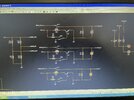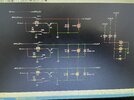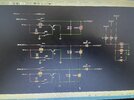Sorry, that cannot work; two reasons:
The transistors are in "emitter follower" configuration, which gives current gain but no voltage gain; the emitters will be at around 0.6 to 0.7V below the base voltage regardless of collector supply.
And, you cannot supply a motor from a resistor divider laike that and get a stable voltage; ie. R4 would only pass 4mA if directly shorted to ground.
The motor current will depend on its speed and loading.
To drive a voltage to grounded load from a supply voltage above the logic level, you need two transistors; the first switching to ground, and that switching a PNP or P channel FET with it's emitter or source fed from positive, and the base or gate of that fed via resistors from the collector of the first transistor.
With two or more different voltages feeding the same load, you also need a diode between each PNP collector and the load (motor) to prevent "back feeding" from a high supply to a lower one.
Edit: Thinking about the motor voltage & current requirements, you could use three switch circuits all supplied at 12V, and a couple of eg. 1.3W zener diodes in series with the appropriate transistor switches to drop the voltage at the motor. A 2.4V and an 8.2V zener (in conjunction with the anti-backfeed diodes) would give around 9V and 3V.
See the right hand half of this example, the high side PNP switch:






